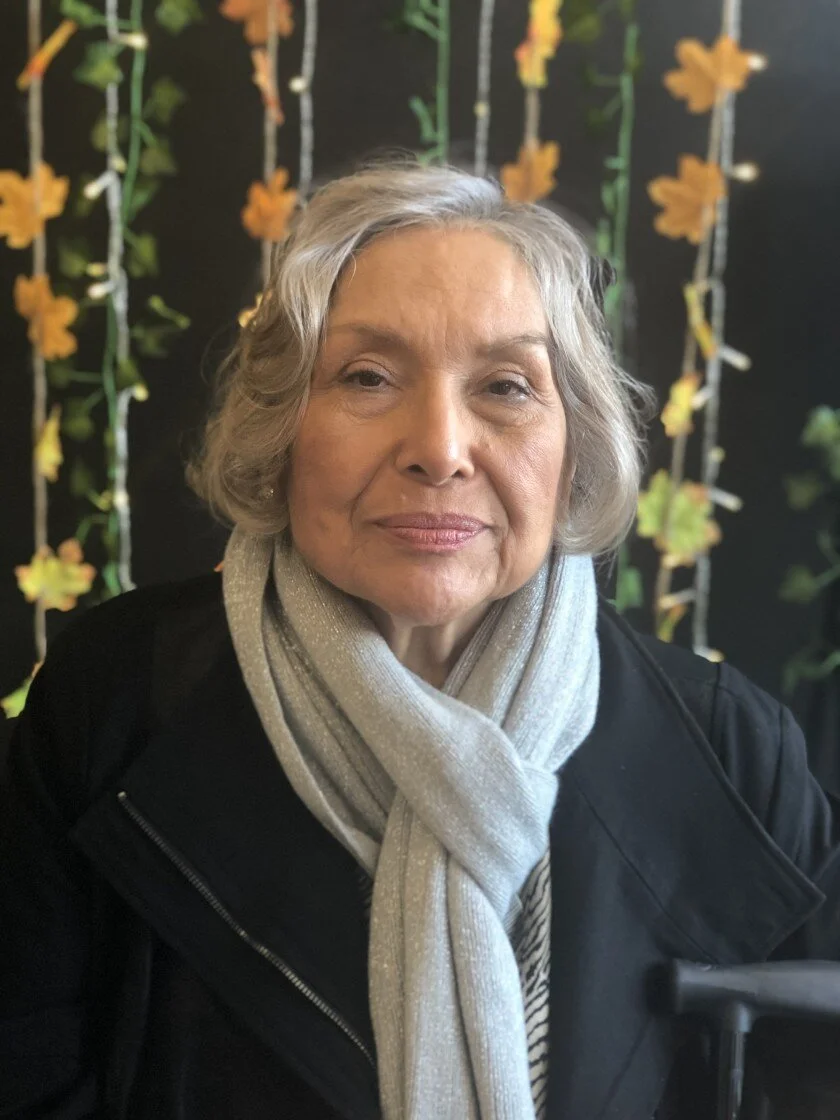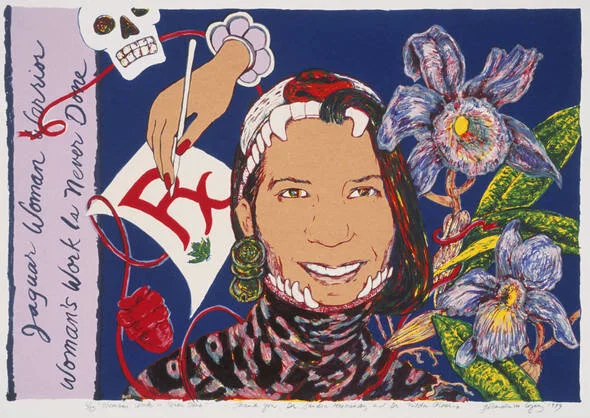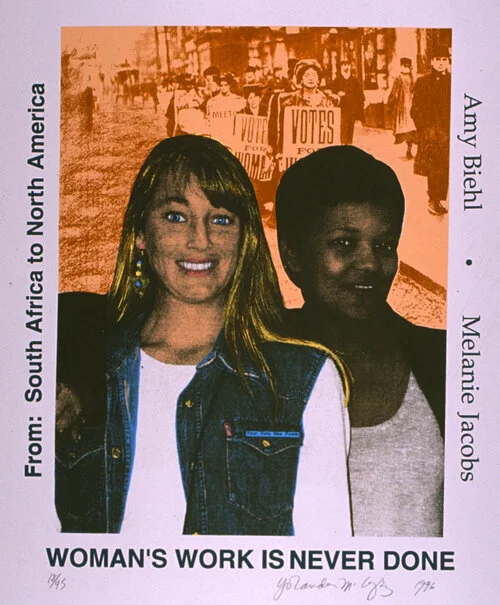Honoring the Life & Iconic Feminist Art of Yolanda M. López
¡Yolanda M. López presente! (November 1, 1942 - September 3, 2021)
By Karen Mary Davalos
In the 1970s, Yolanda M. López produced the most iconic and widely circulated images of the Chicano Movement. She is best known for her series that transforms the Virgin of Guadalupe into a new vision of Chicana womanhood and subjectivity, challenging patriarchy and sexism with Mexican American communities and the broader white-dominated society. Produced in 1978, it is among the first visual expressions that reclaim Guadalupe as a feminist icon of empowerment. This alternative representation of Chicanas visualized the now-popular intersectional feminist theory that understands racism, sexism, and classism as a matrix which structures the inequalities that impede women’s lives. That year, she also created the iconic poster “Who’s the Illegal Alien, Pilgrim?” Challenging the Carter administration’s immigration plans, the print continues to circulate and mobilize communities against anti-Mexican and anti-immigrant policies.
Her identity as a Chicana feminist and her artistic training occurred on the picket lines of the Third World Liberation Front at San Francisco State College (now San Francisco State University) and in the streets of San Francisco’s Mission District. Her aesthetic expression merged the struggle for equity among women, people of color, the poor, and workers. In the 1970s, when she returned home to San Diego, she developed a language for her artistic vision while training with Allan Sekula and Martha Rosler at the University of California, San Diego. She received the MFA in Visual Arts in 1978. Although at the time of her application to the program she did not recognize the deconstructive and semiotic emphasis of the art department, it matched and fueled her intersectional critique of sexism, capitalism, and racism. Over the years, her feminist conceptual approach to art allowed her to resist romantic representations of indigenous cultures and women. Her sharp wit and performativity found its way into her installations and video, as well as her photo collages that informed the triptych and her posters and prints.
Popular reviews and earlier art history scholarship on the Guadalupe series contextualize her work in feminist aesthetic reclamations of the goddess, but López declared no spiritual connection to Guadalupe and was not interested in feminine mystical power. She explains in numerous interviews that she was interested in leveraging the sacred power of Guadalupe for contemporary Chicanas, or in her words “ordinary women.” She further explained her intersectional feminist approach in the coauthored essay entitled “Social Protest: Racism and Sexism.” Written with Moira Roth, an art historian and champion of women’s and outsider art, it contends that feminists and art critics must pay attention to the dynamics of race, privilege, and racism in the production, circulation, and valuation of art. Together with her visual expression, it places López in the company of Faith Ringgold, Betye Saar, Nancy Spero, and May Stevens as well as in the intellectual company of Chicana feminist writers, such as Gloria Anzaldúa, Cherríe Moraga, Carla Trujillo, Norma Alarcón, and Chela Sandoval who developed feminist intersectionality in the written form.
López was a conceptual artist. Her ability to render working-class Chicanas and mexicanas as particular yet abstracted dignified subject challenged sexist and racist stereotypes. Her visual language in figuration has confused critics who read her work as folkloric and representational, but her oeuvre it is a conceptual feminist strategy with deconstructivist reformulations that reach beyond autobiography and reparative community representation. The embodiment of her feminist conceptualism is found in the stark or simple backgrounds of the figures or the intertextual complexity of her installations.
Her feminist proposal calls on the social construction of gender and culture, inspiring new subjectivities that avoid sentimental, nostalgic, or romantic images. At Self Help Graphics & Art, she created several prints of the series Women’s Work is Never Done. As a participant in West Coast Conceptual art and its emphasis on verbal and visual puns, Lopez’s series, Women’s Work is Never Done, turns the old proverb on its head. It does not reference the monotonous household labor of women but their engagement with democracy and solidarity. For example, Your Vote Has Power (1997) was intended to provoke then-California governor Pete Wilson. The print depicts an Ecuadorian woman with dark skin placing her ballot in a box. Using her rebozo (shawl), the woman carries a child on her back. López used “the most frightening thing” that Wilson could imagine during his campaign to support California Proposition 187, which would restrict immigrant access to education, health care, and other social services. López strategically selects a fertile Latina who votes to confront the xenophobic misperception of Latinas as welfare moms who burden society. Indeed, an image of a dark-brown skinned woman who is casting her ballot while also caring for a child requires new mental calculations. The intertextual elements are also relevant. Two marked boxes at the top corners of the poster indicate a repeated commitment to democracy. The feminist conceptual proposal is that civic engagement and political representation is women’s work.
Yolanda M. López was an accomplished artist who created iconic paintings, drawings, prints, sculpture, installations, video, and new media, including Xerox-art. Her work is timeless and through the decades of consummate creativity, she’s inspired generations of individuals who are moved by her thought-provoking imagery. In the last few weeks, we learned of her transition to hospice care through her son, Rio Yañez and on Friday, September 3, 2021, he confirmed Yolanda’s passing on social media. “Our current plan is to have a memorial when it is safe for us to gather in large numbers. Yolanda had a specific vision for a large party with food, music and dancing in celebration of her life. The best way I can think to honor her plans is to realize them when it's safe for all of us,” said Yañez. She died peacefully alongside her family and is survived by her son Rio Yañez and daughter-in-law Sarah Guerra. Rest in power and safe travels, Yolanda.
*Images L-R: Yolanda M. López, Self-Portrait; Jaguar Woman Warrior, 1999, silkscreen; Thank You Dr. Sandra Hernandez and Dr. Nilda Averio, 1999, silkscreen; Your Vote Has Power, 1996, silkscreen; Portrait of the Artist as La Virgen de Guadalupe, 1978, oil pastel; Our Lady of Guadalupe, 1978, oil pastel; Who’s the Illegal Alien, Pilgram?, 1978, offset lithograph.
Dr. Karen Mary Davalos is a Self Help Graphics & Art Board Member and Professor of the Chicano and Latino Studies department at the University of Minnesota, Twin Cities.







